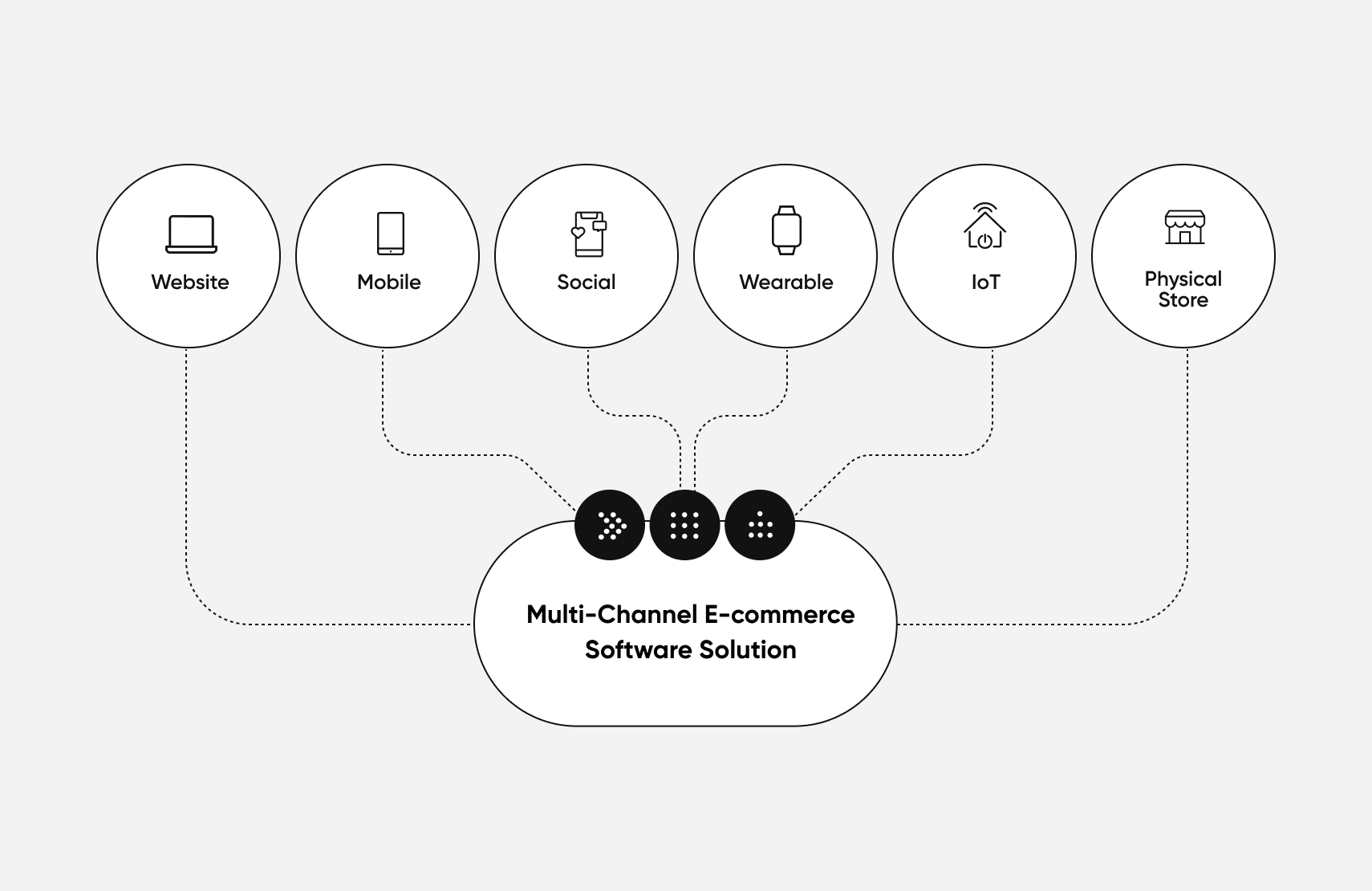What Is Multi-Channel E-Commerce?

Multi-channel e-commerce provides sellers with a unique opportunity to increase their sources of revenue by enabling sales across multiple online channels.
Customers like to interact with a company when and how they want to, and a connected multi-channel e-commerce experience provides them just that.
Headless commerce software helps retailers manage multi-channel e-commerce more easily by separating frontend and backend systems and bridging them with necessary APIs.
You can adopt a headless and multi-channel e-commerce solution like fabric to unify multiple sales channels and centralize commerce management and operations.
[toc-embed headline=”Multi-Channel E-Commerce Definition”]
Multi-Channel E-Commerce Definition
Multi-channel e-commerce is an approach to selling goods and services through multiple channels including websites, mobile apps, social media platforms, digital marketplaces, and even IoT and metaverse experiences.
[toc-embed headline=”Overview of Multi-Channel E-Commerce”]
Overview of Multi-Channel E-Commerce
Online shoppers are far more demanding than they once were. They now expect the same level of service while shopping digitally as they do while shopping in stores. They also expect a consistent shopping experience across every digital touchpoint so they can confidently shop wherever, whenever, and however they want. In fact, 73% of shoppers use multiple channels before completing a purchase.
As for retailers, multi-channel e-commerce provides additional revenue streams to traditional pillars of revenue such as in-store commerce. Retailers can also complement basic e-commerce channels like websites with mobile apps, IoT experiences, and metaverse experiences through multi-channel e-commerce.
It’s predicted that multi-channel e-commerce will grow an estimated 18.8%, producing $417 billion for retailers in 2021, and this will continue to grow as new e-commerce channels are added.
[toc-embed headline=”How Multi-Channel E-Commerce Works”]
How Multi-Channel E-Commerce Works
As the term implies, multi-channel e-commerce provides shoppers with multiple channels to choose from during their digital shopping experience. However, just because a retailer utilizes multiple channels doesn’t mean channels are connected to create a unified experience. If each channel is disconnected, retailers run the risk of creating a “user experience vacuum.”
To prevent this, your retail management software needs to support different buying experiences on different channels. This type of multi-channel e-commerce software exists today and is referred to as headless commerce technology. It allows you to create consistent buying experiences across multiple channels while ensuring product and order data is consistent.
To understand how this works, let’s look at a multi-channel buying experience:
- A person wants to buy a mattress and lands on a retailer’s e-commerce website. The person is offered a $100 discount as a first-time visitor to the website.
- The person adds the mattress to their cart but abandons the cart before checking out. However, before they exit the website, the company convinces the person to sign up for their email newsletter.
- The retailer’s order management software (OMS) is connected to their email software and the retailer emails the person inventory updates about the mattress they almost purchased.
- The person researches the mattress on Amazon and finds similar product images thanks to the retailer’s product information manager (PIM) but not a lower price.
- The person receives an email from the retailer with the same $100 offer they saw on the website but does not purchase the mattress.
- A week later, the person clicks an Instagram ad that takes them back to the retailer’s website. Because of the retailer’s pricing and promo engine, the discount represented in the ad is the same discount represented in the email.
- Due to a connected multi-channel experience, the person purchases the mattress from the website.
In this scenario, headless commerce brings every data point together across all channels, creating a connected shopping experience that converts visitors into customers.
Multi-channel vs omnichannel e-commerce
While multi-channel and omnichannel commerce each involve multiple e-commerce channels, they can be different from one another.
Omnichannel e-commerce puts the customer at the center of the sales strategy. Through integrations, it offers shoppers a unified, personalized, and intuitive buying journey online. No online channel is disconnected from the other online channels. Shoppers can find the best product at the best price, wherever they want.
Multi-channel e-commerce done right can achieve everything that omnichannel e-commerce does. However, it is not required. To connect all the channels in a multi-channel environment, you need a headless commerce setup.
Implementing headless commerce means using one backend system for every channel. In other words, different e-commerce platforms and services are not used for different channels. Content and data are centralized and connected to any channel via APIs.
[toc-embed headline=”Multi-Channel E-Commerce FAQs”]
Multi-Channel E-Commerce FAQs
What is a multi-channel e-commerce platform?
It is a collection of software that helps retailers sell their products on multiple online channels such as social media, a website, and marketplaces like Amazon and eBay. It provides them with a centralized product and order management platform to streamline inventory maintenance, offer personalized deals, and create a connected customer experience.
Which is the best multi-channel e-commerce platform?
Earlier, all-in-one e-commerce platforms like Magento and Shopify were the go-to choice for an e-commerce business regardless of its size. However, these “monolithic systems” broke down as businesses needed to move fast in the face of growing competition and customer expectations. Headless and modular commerce systems like fabric promise scale, speed, and efficiency by leveraging APIs and microservices to connect channels together.
What is the biggest challenge with multi-channel e-commerce?
Inventory mismanagement is the biggest challenge with multi-channel e-commerce. It leads to the risk of overstocking or overselling which leaves customers dissatisfied and pushes them to leave negative online reviews and shop elsewhere. Headless order management systems like fabric OMS direct this challenge.

Content marketer @ fabric. Previously marketing @ KHON-TV and Paramount Pictures.
